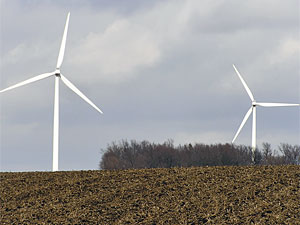It Takes A Village (of scientists) To Reinvent Energy
National Harbor, Md.--Attending the ARPA-E Summit this week was sort of like roaming the halls of clean-tech high school, one investor quipped when I asked him what he thought of the conference. It's an analogy that holds up pretty well.
There were the popular "kids" that everybody wanted talk to--high-profile green-tech investors like John Doerr of Kleiner, Perkins, Caufield & Byers and Vinod Khosla of Khosla Ventures. Authority figures who set the rules were out in force as well, including Energy Secretary Steven Chu, multiple senators, and other high-level Department of Energy officials.
Looking for a clean-energy home run (photos)
And then there were the nerds, the folks who loved taking science classes and building things back when they actually were in high school. These are the types of people who use a vocabulary most of us can barely follow--chemical compounds or industrial processes that you never heard of--because they have deep expertise in a particular field.
As usual, the politicians and money people got lots of attention. But in my mind it's really the class geeks who should be the rock stars at an energy innovation conference.
ARPA-E, which stands for Advanced Research Projects Agency-Energy, was funded for the first time last year with a $400 million budget to award grants to companies and researching pursuing breakthrough clean-energy technologies. On Tuesday, Secretary Chu said that agency is structured around specific technology goals that have a chance at being developed within a few years.
For example, ARPA-E this week announced its grant solicitations for grid storage to complement wind and solar power, for energy-efficient air conditioning, and for efficient power electronics for wind turbines or LED lighting. The agency has already awarded $151 million to researchers developing methods for storing carbon dioxide underground and improving electric vehicle energy storage.
Although it's still young, the agency has gotten off to a good start, according to outsiders and the politicians, such as Sen. Jeff Bingaman (D-N.M.), who were instrumental in getting it funding. Outsiders, such as Doerr and Google director of energy and climate initiatives Dan Reicher, said that the DOE has assembled a top-notch team to vet applications.
Competition for the research money is tight: DOE officials said about three-quarters of the grant applications have been rejected. What's in the running right now? Everything from a Velkess flywheel energy storage system to an Algaeventure Systems plan for extracting algae from water. Entrepreneurs are also pursuing nuclear fusion and the conversion of carbon dioxide and methane gas into a low-carbon liquid fuel.
This photo gallery gives example of the technologies still being evaluated for ARPA-E funding. Making it through the selection process in some way pays twice: a number of companies that have already received research funding were also able to raise money from venture capitalists.
It's pretty much guaranteed that many of these efforts will fail, but that's OK if there are a few technology "home runs" that come out of ARPA-E, say DOE officials and investors. After that, though, there's perhaps a bigger challenge: getting great clean-energy technologies to scale.
http://news.cnet.com/8301-11128_3-10463851-54.html?tag=mncol;posts
Top of blog: http://www.usaalternativeenergynow.blogspot.com/
Subscribe to:
Post Comments (Atom)



No comments:
Post a Comment